#more art of them to come because its pure comedy
Explore tagged Tumblr posts
Text

Mod: a quick drawing of an interactions these two had during an rp (yet silliest thing to come)
The other Enderman is Griffin from @griffin-the-enderman
Context- They barely met and they already started to insult eachother, and fight too
:)
#draco#rp#original character#original art#griffin-the-enderman#Griffin#more art of them to come because its pure comedy
19 notes
·
View notes
Text
One of the most fascinating pieces of movie analysis I've ever read is J.B. Kaufman's thesis of the "two different Snow Whites" in Disney's Snow White and the Seven Dwarfs.
He writes about this in both of his two books on the making of the movie, The Fairest One of All and its companion piece Snow White and the Seven Dwarfs: The Art and Creation. His argument is that Snow White's two leading animators, Hamilton Luske and Grim Natwick, each gave Snow White a slightly different personality when they drew her. A close look at the movie, and knowledge of who animated which moments, reveals subtle differences in Snow White's expressions and body language. Luske, her head animator who handled the majority of her scenes, portrayed her as a more purely innocent, childlike character, while Natwick, the creator of Betty Boop, gave her a little more maturity, sophistication, and sauciness.
You can see the difference, for example, when comparing her girlish interactions with the animals in "With a Smile and a Song" and "Whistle While You Work" (animated by Luske) to her flirtatious smiling at the Prince from the balcony, or her "mothering" of the dwarfs as she examines their dirty hands (animated by Natwick). Or her responses to Grumpy in the scene before the Washing Song: as she asks "What's the matter? Cat got your tongue?" she looks at him with a devilish grin (Natwick), but then when he sticks out his tongue at her, she reacts with the most wide-eyed, girlish shock (Luske).
Now, I don't know if these two men really held different views of Snow White's character, or if it just worked out that Luske drew Snow White's more innocent scenes while Natwick was assigned her more grown-up moments. But either way, Kaufman argues that this "tension," the movie's constant push-and-pull between "Snow White as a wide-eyed innocent girl" and "Snow White as a self-assured young woman," makes her an especially interesting Disney Princess. I tend to agree, especially because, miraculously, there's no sense of inconsistency in her character. She comes across as a young girl on the verge of womanhood, who naturally can still be naïve and childlike in some ways, but more grown-up and clever in others.
This thesis makes me wonder if certain "tensions" in other movies are the result of different viewpoints within the creative team.
For example, in Beauty and the Beast.
Linda Woolverton has often talked about her feminist goals in writing Belle's character, which sometimes clashed with her collaborators' visions of Belle as a more traditional fairy tale heroine. It just might have been those clashing viewpoints that created the dichotomy in Belle that I personally think makes her interesting. On the one hand, she's a strong-willed misfit rebel, partly inspired by Jo March in Little Women and by Katharine Hepburn's screwball comedy heroines, who longs for adventure, isn't looking for romance until she unexpectedly finds it, stands up to men (and beasts) who abuse their power, and refuses to let anyone dominate her. On the other hand, she's a sensitive dreamer with delicate beauty and balletic grace, who wears pretty, ladylike dresses, adores fairy tales and love stories, and is sweet, nurturing, and almost motherly to her friends and loved ones. Yet somehow these two sides of her character co-exist with no sense of inconsistency between them.
There's also the dichotomy between the two different views of the Beast that the movie seems to present at once. On the one hand, there's the Beast as an unseemly brute, who's beastly form is both a just punishment for his flawed character and an outward symbol of it, and who needs to be "tamed" into proper "human" behavior, culminating in his physically turning human again. On the other hand, there's the Beast as a suffering, self-loathing outcast, unfairly hated, feared, and dehumanized, whose plight under the spell can easily be read as an AIDS allegory, and who needs to be accepted and loved as he is. I suspect that this also stems from different goals and viewpoints in the creative team. (For example, Howard Ashman's clash with the directors over whether the Prince should be a child or a man in the prologue – the former would have made him more "tragic" but the latter makes his punishment more "fair.")
I'd like to read an analysis of these "tensions" similar to Kaufman's analysis of the "two different Snow Whites."
#disney#snow white and the seven dwarfs#snow white#j.b. kaufman#beauty and the beast#belle#the beast#animated film#analysis#characterization#dichotomy
119 notes
·
View notes
Text
You Don't Remember Muncher

Sony, as a film-making company, has reeked of desperation for at least a decade at this point. They have IPs that they know SHOULD be making them more money but they just. Can't. Get them to. And sometimes this results in them taking some big creative swings, to be completely fair - I love the Spider-Verse movies, and you don't get movies that expensive and conceptually heavy with a studio executive who's playing it safe. And I think the fact that they keep taking these big swings even when some of them end up duds like Sausage Party is commendable.
But I do think one of their big problems is this inability to understand that 1. films are a form of art and 2. what art is. They're good enough to understand that artists know what art is, which is more than a lot of studio leadership can say, and those big creative swings they take come from trusting artists to do their art thing. And even their misfires tend to have laudable stuff - Sausage Party may be an SNL gag that someone decided to stuff full of the most dated racism and bigoted jokes imaginable to get up to movie feature runtime, but the animation in it is oddly beautiful, even when depicting things that are repulsive. Like a protestant on the way to Dracula's castle, the heads at Sony seem to treat their artists with respect despite not understanding why they gave them a rosary and other primitive superstitious charms to protect them from vampires.
But when they have to make choices themselves, hoo boy, those poor bastards. They don't know what they're doing.
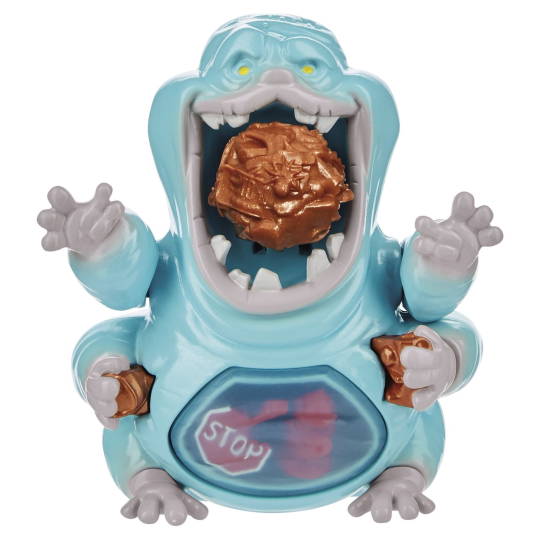
So Ghostbusters is one of those valuable IPs Sony is desperate to monetize, right? They just know they can have a huge hit on their hands with Ghostbusters. It was popular in the 80's, and things that were popular in the 80's are HUGE now! Look at that Stranger Things, baby!
Now, the heads at Sony may not be able to understand art, but they try. They are at the very least good at picking apart a piece of art and sussing out what ingredients made it, like Claire Saffitz trying to recreate an oreo. For their 2016 reboot, they correctly deduced that the original Ghostbusters was 1. a comedy 2. starring at least two actors from SNL and using their star power for promotion and 3. was liked by nerds because the heroes are out-of-shape nerds rather than chiseled Rambo/Arnie types. Also it has ghosts in it, probably.
Now, the problem is, the SNL actor-led comedy was taken out into a dark alley and slowly beaten to death by Adam Sandler and his cadre of goblin men starting somewhere around the time Little Nicky was made. It gave way to the era of cringe comedies like The Hangover and Judd Apatow bromances, which were led less by SNL stars and more by actors and actresses who'd gotten their start on NBC thursday night sitcoms - a minor difference, perhaps, but notable I think. And, like, even then, by 2016, that era was also pretty much over. The cringe comedy was a dying genre. Comedy itself, at least pure comedies, was kind of losing its place in film, being supplanted by action movies with more quips than they used to have. We were three years deep into THE WHEDONING.
But being three years behind the curve has never been a problem Sony worried about. I mean, historically it should be, but they never do. So Sony tried to assemble the best Ghostbusters they could make from the ingredients they could suss out, using the closest equivalents they could make. Grab some of the actresses from Bridesmaids, and an SNL star or two if you can. Kristen Wiig and Melissa McCarthy have a pretty good banter going on ala Bill Murray and Dan Akroyd, really put them front and center. Oh, and we sussed out another ingredient! The original Ghostbusters had Sigourney Weaver as a love interest, and she was the star of Alien, which our Sony genre determining bot claims is an action movie, so let's get a hot action star as a love interest. Chris Hemsworth! Oh, we can make him be a silly goober like we did with John Hamm in Bridesmaids! People love handsome guys being silly goobers! (in this, Sony is correct)
The result was... fine, I think, if missing a few crucial ingredients. You know the ghosts in Ghostbusters? First syllable of the title? Most of the ones in the 2016 movie are just, you know, transparent humans, maybe a bit bluer than normal, making maniacal faces. Whereas in the original:
youtube
Well, they got some fucked up freaks in the original.
A lot of fans didn't like the 2016 movie, some for stupid sexism reasons, some for "I don't see why you need to remake Ghostbusters at all really" reasons, and some for, like, just personal taste reasons. It did not provide the big box office hit Sony wanted. Their first attempt to recreate the oreo was a failure.

So they go back to the drawing board, listening to the loudest, angriest criticism and looking to what's working outside of their influence for answers. Fans thought the 2016 movie was too different, not reverent towards the original as the perfect golden calf of Bill Murray comedies that it is. So this new reboot would be oozing with reverence. Fans didn't like the cast of ladies, so, yes, got it, scrap the lady-led ghostbusters.
Star Wars Fans loved that J.J. Abrams Star Wars reboot, The Force Awakens, for being a sequel rather than a full reboot, but also for just telling the same story they already love but slightly different. And nerds in general still fucking love that Stranger Things show - they even had an episode where the Stranger Things kids wore ghostbusters costumes! Hey, there's a million dollar idea, Stranger Things kids... as ghostbusters...
Now, the one thing they can't take from The Force Awakens is copying the tone of their original movie, because they tried copying the irreverent tone of the original Ghostbusters and fans did not like it. They need to be reverent to the original, because that's what The Force Awakens, even if showing reverence at all is antithetical to the tone of the original movie itself (which it is, because Ghostbusters is an irreverent Bill Murray comedy, like that's its whole schtick). But if they can drape this new-found reverence in 80's nostalgia, maybe, just maybe, nostalgic fans will be too dumb to notice.
And hey, they love that Stranger Things, which is a big homage to The Goonies and E.T. and Steven Spielberg-esque stories about pubescent kids going on perilous adventures where they face bad guys and learn life lessons in the process, reverent but dated in the same time period as Ghostbusters. And what an idea... Stranger Things kids... as ghostbusters...
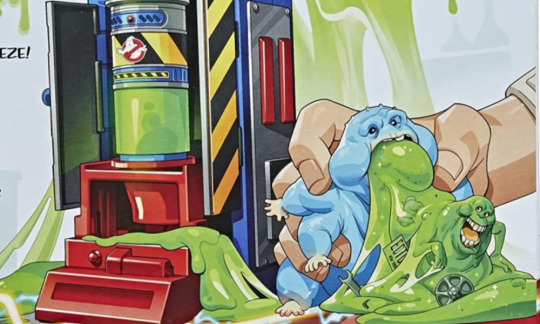
This was admittedly a lot of preamble to get to the actual topic: Muncher. See, in that Force Awakens style, they needed to not only bring old characters from Ghostbusters back, but also make new characters who are really just the old characters but slightly different. For example, The Force Awakens brings us BB-8, who's basically just R2-D2, but visually different enough to feel new, and maybe a little cuter. Instead of moving on treads, he moves on this big ball, which is more complicated from a puppetry aspect and thus looks a lot more impressive and just a bit more "modern" while still basically being R2-D2 again.
Such was the genesis of Muncher.
Slimer (originally called Onionhead by the production staff and John Belushi's Ghost by Bill Murray) wasn't intended to be the franchise mascot, in part because Ghostbusters was never meant to be a franchise. He was a one off ghost who's iconic design and role as the first ghost to be busted made him a fan favorite, and eventually became, like, the ghostbusters' dog in the cartoon series. We love that for him, but the fact remains that Slimer's success was accidental.
Muncher, by contrast, was an attempt to recreate Slimer. But different! He's a gross gluttonous monster, because that's what Slimer is, but there's a lot less focus on wet goo when he eats and more solid chunks. See, it's different? And you know what's popular now thanks to, like, a cracked article or something? Tardigrades! They're these cool little microscopic things that everyone's making into monster designs now, they're even on a Star Trek! Why, if we made Slimer 2 - err, that is, Muncher have some tardigrade elements, he'd look weird and, like, modern - but not too modern! Like Slimer, but different!
Before Ghostbusters: Afterlife came out, there was a LOT of Muncher merchandise. A lot. Which makes sense, Slimer had so much goddamn merch in the heyday of the original Ghostbusters. There was fucking Slimer toothpaste. Toothpaste! From Slimer's teats!

It looked identical to Slimer bubblegum.
But, for whatever reason, Muncher did not connect like Slimer did, and so Sony did a last minute trend-chasing pivot and tried to focus on the new hotness: cute baby versions of characters who were old and not cute in the original movie.
youtube
I don't know if this scene was planned to be in the movie before The Mandalorian was a big success, or if it was a hasty addition to it, but it doesn't matter, because what does matter is the late marketing shift to focus on these little fuckers, and giving them lots of toys. They're already in the marketing for the sequel, where Muncher is nowhere to be found.
Because you don't remember Muncher, do you?
Muncher didn't connect. They took a swing with Muncher and they fucking whiffed. They made a shitload of Muncher toys and all those little blue fuckers ended up clearanced to Hell. Muncher is a failure, a loser.
You don't remember Muncher.
And you never will.
65 notes
·
View notes
Text
Dragon Ball Z: Abridged Episode 60 Review
What does it mean for an abridged series to go even further beyond?
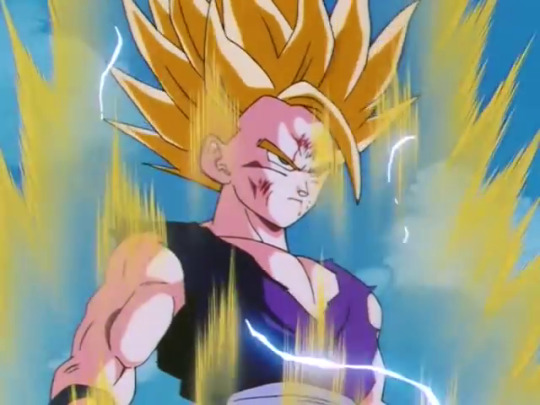
Part I
I started this review series in 2015 because I loved Dragon Ball Z: Abridged, and I needed there to be writing out there that explained why I loved it so much.
It’s a funny thing, re-reading all of my old writing about it. Part of the nature of a weekly review series is that you tend to zoom in on the particulars, as that’s where the meatiest criticism lies. Going over the specifics of the story’s structure, how details in the show add to a greater whole, it’s all part of the process of finding out why something in a show works, or sometimes, doesn’t work.
It’s in those details though, that you come to a greater whole. By recounting the specific ways in which a story is threaded together, week after week, episode after episode, you start to bring forward recurring ideas, and piece together aspects that continually make a show work, and contribute to the greater whole. And when you’re critiquing a masterpiece, a show so lovingly crafted that every single detail lines up perfectly for its conclusion, you eventually are able to tie those thoughts together into what is hopefully a masterful conclusion of your own.
Dragon Ball Z: Abridged is the best possible version of Dragon Ball Z.
This might be the most contentious statement I’ve ever made about this show. It’s a statement I know for a fact the creators disagree with. But it’s a statement I believe wholeheartedly, and I even would go so far as to say that Dragon Ball Z: Abridged is closer to the spirit of the original Dragon Ball than Toriyama managed to pull off himself.

The original Dragon Ball manga is a masterpiece of its own. Akira Toriyama did a phenomenal job weaving together hilarious gags with thrilling martial arts action and compelling character growth, all while centering one of the most lovable, fun, and pure-hearted protagonists to ever be written. There’s a reason that it spawned an entire genre of imitators, and that’s because its blend of action, comedy, and growth were all executed masterfully.
I don’t think that Dragon Ball Z ever manages to capture that magic the way the original does. That’s not to say that Dragon Ball Z is a bad show, but by the time Raditz enters the story, the manga and show both change into something much more akin to a melodramatic soap opera. There’s so much waxing from the characters about how powerful these foes they’re facing are, and there’s very little levity sprinkled throughout these long, drawn-out fights, as the circumstances feel too dire for the characters to make jokes and be silly.
Silly humor was core to Dragon Ball’s charm though. The very first fight in the first World Tournament Arc is a gag about how Krillin is able to beat a martial artist who has never bathed and uses stench as a weapon, because he doesn’t have a nose to smell him with. The best side character in this series goes from being an angry, murderous criminal to being a cheerful, innocent sprite every time she sneezes, and she always sneezes at the worst possible moments for everyone. Hell, the entire Red Ribbon Army Arc is a joke about how Goku completely obliterates a major threat to the world on a whim, because none of them are martial artists, and not a real challenge as a result!
The very magic of Dragon Ball Z: Abridged is that it takes this melodramatic source material and finds the space within it to make jokes again. The Saiyans are a world-dooming threat, but Nappa is hilarious, and I will forever quote everything he said. Freeza is a genocidal tyrant who has taken the galaxy by force, but even when the world around him is unable to laugh, his spoiled, petulant attitude is funny as hell, and full of delightful dark humor. Even the darkest timeline of Trunks’ future is filled with jokes, whether that be the genuinely despicable ramblings of TJ and the Wombat, or a 50-year-old Bulma making a pass at Gohan, perfectly fitting her original boy-crazy characterization.
And phenomenally, Dragon Ball Z: Abridged manages to do everything I just mentioned without sacrificing an ounce of drama. Goku’s battle against Freeza is desperate, and his Spirit Bomb failing rips the ground out from under you. Future Trunks’ battle against the Cyborgs is tense, and his first transformation into a Super Saiyan is gut-wrenching. Even in the first season, before they fully found their feet, Team Four Star managed to make the battle between Goku and Vegeta every bit as tense as it needed to be, while still incorporating a constant stream of jokes.
So where does that leave us with Episode 60?

Part II
What, exactly, is the purpose of an abridged series?
I think it’s fair to say that an abridged series is, at its core, an adaptation of a work of art from one medium to another. This is a statement I’ve made before in these reviews, but I don’t think I’ve ever elaborated on it. It feels rather obvious to me that an abridged series be treated as any other adaptation might, because at the end of the day, that’s what artists like Team Four Star, LittleKuriboh, and Something Witty Entertainment are doing. They are adapting a work from the medium of televised anime to the medium of a comedy YouTube short, and making the same kinds of adaptational decisions in creating these series as a production team turning a book into a movie.
You can see this question of adaptation present itself as far back as some of the earliest abridged series, like Avatar: The Abridged Series. Most of that show intentionally leans into the weakest aspects of Katara’s character, emphasizing her feminity, thirst for cute boys, and quick temper far more than the original show ever did. Yet, in its last episode, Katara undergoes a significant transformation in the face of Paku’s sexism, and is completely reimagined with a new voice actress as she goes on a rant about the sexist ways she’s been written, and her refusals to stand for it anymore. The last episode of this abridged series ever made goes out of its way to critique both itself and its source material in its last episode, and it begs the question of how far an abridged series adaptation can go.
Sword Art Online: Abridged famously goes even further in its critique of its source material. Almost every character is completely rewritten to serve as both a more accurate representation of online culture, and a deconstruction of their original persona, with Kirito in particular standing out as a fantastic depiction of the kind of loneliness and self-isolation that comes with being a try-hard edgelord. It takes an entire season of the show for Kirito to learn to truly connect with other people, and that growth is made all the more satisfying by showing genuinely difficult it is for him to maintain anything resembling a positive friendship with anyone because of those edgelord tendencies.
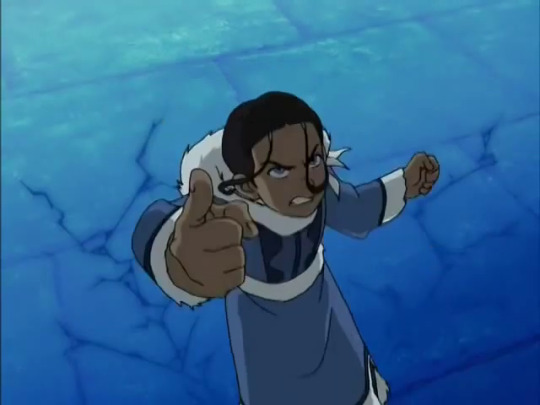
These shows both have very different purposes, in large part due to the evolving understanding of what an abridged series is capable of between their creations, but they both raise a fairly similar question: what happens when you give everyone with a video editor and internet connection the ability to re-tell someone else’s story?1
The answer here is something I think is quite beautiful. The abridged series thrives outside of the realm of copyright locked down by rent-seeking ideas landlords, and allows individuals, groups, and communities to reimagine their favorite stories. Sometimes, what they imagine is as simple as few extra jokes, or a simple rant about the sexist way a character is written, and sometimes, what they imagine is a completely new version of the story that actually raises interesting questions and showcases compelling characters.
I don’t think it’s a coincidence that the abridged series found its roots in the copyright-less utopia of early YouTube, when anyone had the freedom to take something they loved or hated, and transform it into something completely different. The rise of Content ID has long since taken away this pure, unadulterated freedom from us, and I truly feel that the internet is worse off for it.
When it comes to Dragon Ball Z: Abridged, the show we are watching is the result of a bunch of people who love Dragon Ball and Dragon Ball Z more than anything else, asking what they can do to make the show funnier, smarter, and more meaningful. Team Four Star found their footing as writers when they began to focus on the comedy that came from character interaction, as we watched these huge personalities clash, and for every funny joke they were able to draw out of that foundation, they managed to draw even more pathos and catharsis for these characters.
Which is to say, Team Four Star took the idea of an abridged series, and went even further beyond.

Part III
Episode 60 of Dragon Ball Z: Abridged is a massive episode that provides a satisfying resolution to the whole series, and nearly every storyline running within it. It also highlights the relationship between its characters fantastically, placing most of the story’s emotional weight on the fractured dynamic between Gohan and his chronically absent father, Goku.
The entire first part of the episode is focused on the tension between who Gohan fundamentally is, and the man his father expects him to be. Goku has, in a stroke of fighting genius (the only genius he is capable of), perfectly planned out this encounter between Perfect Cell and Gohan. He’s manipulated Cell into hosting a tournament for the fate of the world, and placed his son in the perfect position to take down Cell and ascend to power greater than anyone has ever seen. And it’s all ruined because, as Piccolo perfectly points out, Gohan hates fighting.
The subtext of emotional strain between Goku and Gohan has been running throughout the entire series, but it’s finally brought to the forefront of the text in this moment. We see Gohan wrack himself emotionally and Cell wrack him physically, as he and Cell both try to force himself to fill the role his father has placed him in. Even as Cell violently births his own progeny to wreck Goku and his companions, in a last ditch effort to stir a fire within Gohan, Goku’s son cannot bring himself to be the warrior his father believes him to be.
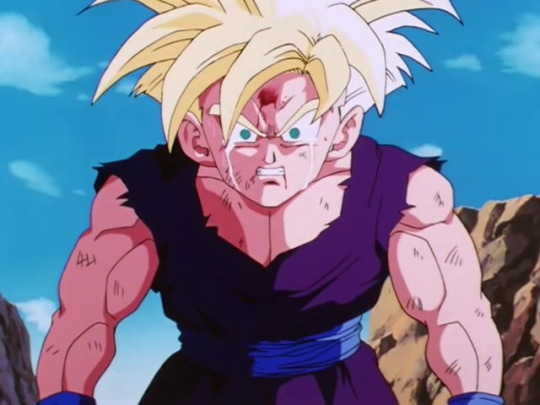
Android 16’s speech and subsequent death changes all of that for Gohan. In a moment set to a breathtaking cover of Unmei no Hi, Gohan internalizes the lesson passed onto him by Android 16, who thoroughly eviscerated the liberal pacifism Gohan has been trying to embody. And Gohan gets angry. So angry that his power skyrockets, and he becomes a Super Duper Saiyan.
Super Duper Saiyan Gohan is fucking terrifying.
Throughout Dragon Ball Z: Abridged, we’ve come to know Gohan as an incredibly intelligent, exuberant, compassionate bookworm. Even though he doesn’t want his entire life to revolve around education and books, he still revels in knowledge and the opportunity to learn, and some of his cutest moments are when he is allowed to be truly childlike, like when he eagerly investigated Cell’s time travel pod for clues.
Every single ounce of compassion and love for life Gohan had before transforming into a Super Duper Saiyan is replaced with rage. Rage at Cell for destroying Android 16, a beautiful soul who did nothing wrong. Rage at Goku for thrusting him into this fight unprepared, and taking away the only hope he felt by throwing Cell a Senzu. And rage, most of all, at the world, for being so fucked up that he was forced into this situation to begin with.
Gohan’s rage is cold though. There is no righteous fury like Goku, no petulant tantrum like Vegeta, no sorrowful torment like Trunks. This Gohan slowly defines the word “filicide” for Cell as he effortlessly commits it, wiping out all of Cell’s children so quickly even Freeza, the most murderous being we’ve met in this universe, would be impressed.

That very rage drives all of Gohan’s decisions, as he lords his power over Cell and takes every opportunity to torment him. He blows away all of Cell’s limbs with a Kamehameha, and then guts him with his fist so hard that he throws up Android 18, and loses his Perfect form. It’s this blindness by rage that leads to Gohan’s greatest mistake, of not finishing off Cell, who tries to blow himself and the planet up in order to gain some kind of victory.
What’s perfect about this moment though is that while Gohan feels entirely responsible for his mistake, Goku knows better. He recognizes the responsibility he bears for Gohan’s bloodlust, and knows that the only way to make it right is to remove Cell from the equation altogether, teleporting the two of them to King Kai’s planet in bold move to save the earth.
Goku’s decision to sacrifice himself also recalibrates Gohan’s perspective, guiding him away from the rage that filled him before, so that when Cell returns, and murders Vegeta’s baby boy, Gohan doesn’t hesitate to put himself in harms way to protect Vegeta from a deadly blow. It costs him an arm, but his commitment to protecting others, even when it’s stupid, and even when it gets himself hurt, is true to the Gohan we’ve come to know and love. All that’s left for Gohan to do is face off against Cell, one Kamehameha against another, and draw on the strength and fighting spirit of his father to deliver the final blow.

Goku and Gohan aren’t the only two characters whose relationship is deepened in this episode. Vegeta’s enraged cry of “MY BABY BOY!” when Cell kills Trunks shows just how much Vegeta has come to love his own son, despite the airs he puts on to the contrary. Piccolo’s love for Gohan is also expressed incredibly here as he lectures Goku for not paying attention to the needs and wants of his son, who just wanted to receive love and affection from his father.
In fact, the love that these characters have for each other, and the ways they express it, is a theme that runs deep in this episode. Trunks love for all these folks around him is shown as he dutifully delivers them all Senzu Beans, quietly making silly puns to each of them. Krillin’s love for Android 18 is displayed wonderfully, whether through him gaining the strength to stand up to Vegeta because she’s resting in his arms, or through him wishing her and her brother free of the bombs implanted in them. Even Yamcha and Tenshinhan are given a moment of brotherly love, as they express for the first time in words how much they both mean to each other.
That very love is also what drives Goku to refuse to be resurrected at the end of the episode, despite Cell having been defeated. He genuinely loves Gohan, Goten, Chi Chi, and all of his friends, and knows that the best way to show his love, for once, is actually to be away from them, and spend time in heaven with King Kai. He’s not afraid of the great change this will be, both for him, and the people he loves, and is willing to embrace the afterlife if it means safety for his loved ones.

Goku’s speech about embracing change and not being a part of his loved ones’ life anymore is also very easy to read as a coda to Dragon Ball Z: Abridged itself. He, and all the rest of these characters, are saying good-bye to us, the audience that has followed them on their journey for years, and they are all embracing the truth that it is beautiful to let this show end on its own happy terms. It’s ironic that, at the time, Team Four Star announced that they would be trying to continue this series, but it’s clear they grew to see the wisdom in Goku’s words too.
A similar message can be found in Cell’s final moments, as he gives us a beautiful rendition of Frank Sinatra’s My Way. Team Four Star, just like this villain, has spent nearly a decade re-telling the three sagas of Dragon Ball Z they loved the most, and at every turn, they chose to do it their way. Sometimes, in the early days, that meant reference-based humor that aged like milk, but more often than not, it meant leaning into their strengths as comedic writers, taking creative liberties with the source material, and working to elevate the text of Dragon Ball Z to something even better than the original show.
I don’t know what to call that other than Perfect.

Epilogue
The journey that I’ve been on with Dragon Ball Z: Abridged, both as a viewer and critic, has been an incredible one. It has meant more to me than just about any other show I’ve ever watched, and stands up there with some of the most impactful art that I’ve experienced. It’s a show I’ve watched when I was suicidally depressed to find some sort of levity, a show I found enough depth in to meticulously critique every episode, and a show I’ve gotten even my shounen-indifferent partner to get extremely hype about, as I showed them the entire show in the lead-up to its fantastic finale.
What Team Four Star managed to create in Dragon Ball Z: Abridged is something genuinely special. It’s a show that makes me laugh harder than just about anything. It’s a show that’s made me cry more times than I can count too, as I was tearing up multiple times while re-watching the finale for this review. It’s even a show that I get to cringe at sometimes, when I think of the early seasons, but that cringing makes it all the more impressive how much Team Four Star improved as storytellers, and elevated their craft to tell their version of Dragon Ball Z better than anyone else could.
I love Dragon Ball Z: Abridged. I will always love Dragon Ball Z: Abridged. And even though it’s over, I know it will always be there for me, waiting for me to tag along with Goku, Krillin, Vegeta, and Gohan, as they power up and save the world.
Rating: 5/5
If you like my writing, consider supporting my continued film criticism addiction on Patreon.
Stray Observations
1This question, you might notice, is exactly the same question raised by the existence of fan-fiction, and this is because abridged series are, at their core, no different from any other form of fan-fiction. An abridged series does, by its nature, require more work and expertise than a piece of prose on Archive of Our Own, but all it achieves, in the end, is a greater level of accessibility, like the difference between a written article and a video essay.
I genuinely adore that in this episode, when Piccolo goes to yell at Gohan to dodge, he’s already dodging Cell perfectly. What a great ending to a running gag.
Yamcha’s every line in this episode is great too. He just wants to be included, whether that’s in Team Three Star, or Cell’s plans for tournament entertainment, and I love him for that.
Super Duper Saiyan is also, just, fucking brilliant. Like, what a great way to use Goku’s silliness to get around the awkwardness of these forms being called Super Saiyan 2 and Super Saiyan 3. Vegeta calling the next form Super-Dee-Duper Saiyan just sells the joke even further. If the show had continued for another season, I genuinely would have loved the comedy of these characters shouting about being “Super-Duper Saiyan” or “Super-Dee-Duper Saiyan,” and would love to see a mock-up of Goku’s “even further beyond” speech with these terms in Team Four Star’s style.
Krillin Owned Count: 0. And as a huge fan of Krillin, yeah, this makes me real fuckin’ happy J
Also holy shit, did Krillin cum 39 times??? That’s super impressive for a cis dude, mad props.
98 notes
·
View notes
Text
Dr. Stone S3 Episode 1: New World Map
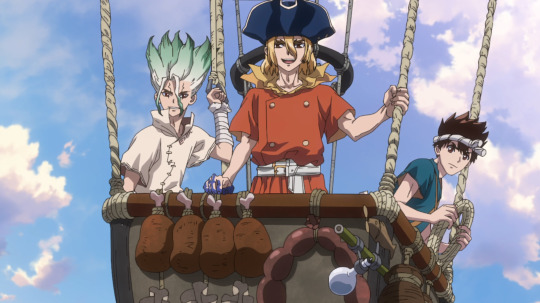
Looks like science is back on the menu boys! Dr. Stone returns with its third season (which is 2 cours once more!), with the goal of creating a ship to cross the ocean. An ambitious goal considering the technology of their time, but one that come Heaven or Hell Senku will complete. Though every dream that aims for the stars starts with a humble beginning, this one starting with a search for oil and the beginnings of agriculture.
It's been a while since I've really watched or paid attention to Dr. Stone stuff, so I've been reminded of how enjoyable the art and designs are for this series. They're incredibly tight and creative, and plenty vibrant without being overly contrasty or excessive in terms of color design. It's a really great balance that puts the focus on stranding out, and being strong.
And one last thing before I get into it, the direction for Dr. Stone has never really stood out to me. It's one of those things that just focuses on not getting in the way of the story and its characters. It leans perfectly into the comedy and excessive nature, but doesn't attempt to try and put a spin on things or really do anything crazy with it. Not exactly bog standard, but not something that you point out and talk about.
So with that in mind, I'm jumping right into science!
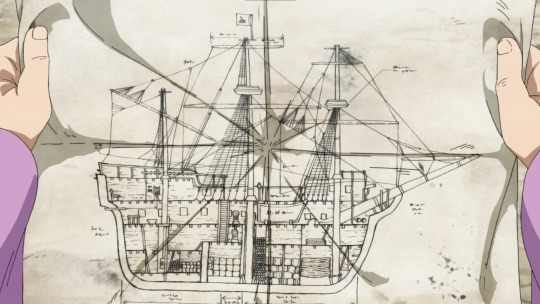
I thought this blueprint was rather fun, not really accurate in any way, but something and interesting to younger audiences for sure. The cross section is a solid idea for showing how it's supposed to look, and there's even measurements just poking their head out from the bottom of the image. But ultimately, it's slightly more than a glorified drawing of a cross section of a ship.
Now, two little tidbits here, not really important but just stuff I found fun. The first is Yuzuriha being put to work, considering her sewing skill it makes sense, but if it weren't clear to others she's the one that's putting together the sails for the ship which was a fun little background detail to add. Similarly, Kinro and Ginro are working together to plane the various logs into workable lumber. They weren't using it, but was fun to see them show off a planer (and helps remind you of the level of technology available to Team Science).
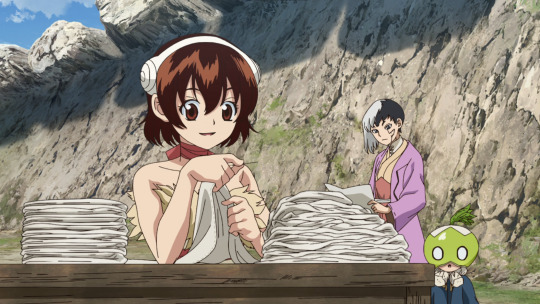
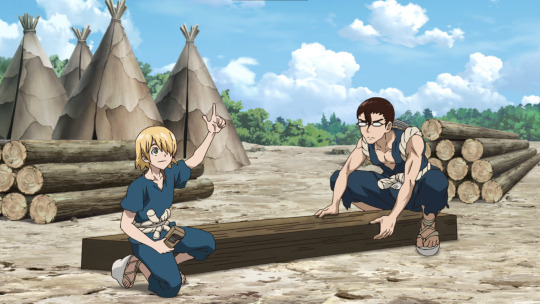
Now, I'm not 100% certain on what sort of tool Ukyou is using here. My immediate thought was a sextant, but that's used for celestial navigation and they're in the daytime and are surveying land. So, due to lack of knowledge I'm chalking it up to "funky telescope for charting topography".
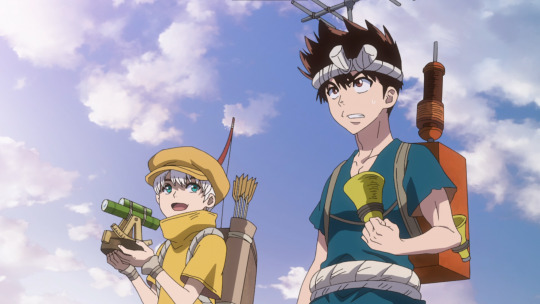
So, maybe not science, but I really enjoyed this piece as a bit of logic behind the crew's search in the skies. Rysui points out the existence of a herd of wild animals. Now, for a herd to support itself, there must be sufficient food in the area, which Team Science also happens to be after. Sort of a two birds with one stone moment that works out quite well for them as they stumble upon wheat, of all things.

So, on the topic of wheat, I was kind of sad that they didn't explain this little piece here. It's a fun and interesting little thing that helps with an overall mundane task. Threshing is the stage where you separate the stalk/straw that holds all the wheat together, and the more traditional way to separate the two is, essentially, to smack it against something. Because of that, seeing it done in a much more refined and controlled manner was interesting, so I was kind of disappointed they didn't add any dialogue to the scene.
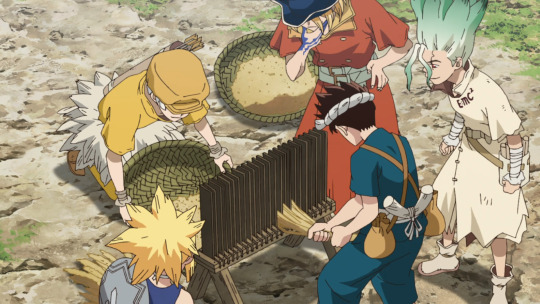
And the last real science-y thing of the episode was a litmus test. A really fun and simple example of the importance of stuff that you might have thought random when in high school. Litmus paper (and acid-base testing in general), is applied in all manner of facets of modern human life. Seeing it as such a simple yet important example was really fun and inspiring, and a cool way to casually teach people about the challenges of agriculture.
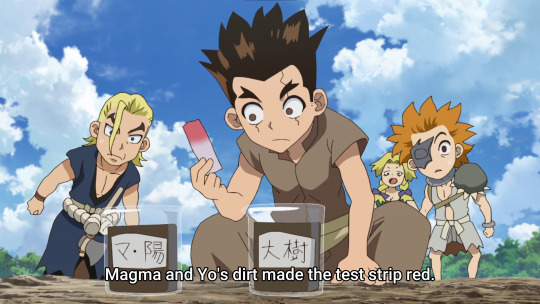

Of course, Dr. Stone isn't purely about scientific advancement, so they throw in some sentimental moments as well. In the smaller dosages that we see them in, they serve the story perfectly to allow for the characters to develop, and to help frame the importance and magnitude of the advancements that color human history.
Though you'd be kidding yourself if comedy didn't reign supreme after science. The sort of chibi style that appears just helps accentuate the ridiculous nature of the comedy, while separating it comfortably from the more scientific or sincere sides. It's basically a textbook approach that's executed incredibly well.

And lastly, Minecraft is in an anime. Yeah. Weird, yet awesome decision to have some of the exposition scenes appear as something styled after Minecraft, given the similarities. Great fun, and a cheap and easy solution to those moments, which can allow them to put more focus elsewhere.

#dr. stone#gen asagiri#senku ishigami#yuzuriha ogawa#dr stone ryusui#ryusui nanami#dr stone#dr. stone new world#dr stone new world#anime recommendation#anime review#anime and manga#anime
9 notes
·
View notes
Text
Oni in contemporary anime and manga 🧟♀️
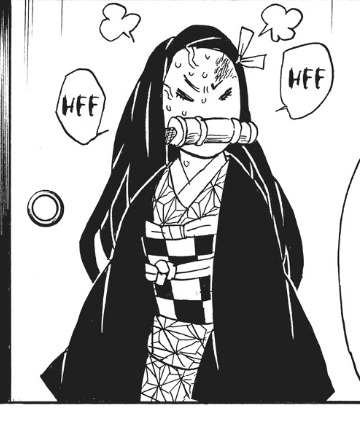
It is funny to think that the Oni concept changed so much during history. Especially in the modern times we start to see big changes in the myths, and in Edo Japan, some towns even start to associate Oni stories to then. It seems kind of weird. Why would a town want to be associate with a being that is a bringer of disease, pollution, barbarian, etc? Well, because just like hero stories would bring people to certain places, the same rule would apply to ghost stories. "The use of legends (as opposed to other genres of storytelling) in this development is noteworthy. As folklorists classify, legends are situated in precise spatial and temporal parameters, in contrast, for instance, to myths, which, invoke abstract scales of space and time" - Carter, 2019; The concept of the Oni changed as much as the Japanese people changed throughout history. There were a lot of types of Onis, but with the modern times, a new type of Oni was born: the kind and benevolent Oni. The writer Hamada Hirosuke wrote a story called "Naita Akaoni - The Red Oni who Cried", that talks about a Red Oni that wanted to be friends with the humans, and so, his Oni friend, the Blue Oni, attacks the humans so that the Red Oni could be seen saving them. "Hamada's Oni are righteous and pure-hearted: the red Oni is friendly and prepares tea and home-made cakes for the humans, while his counterpart, the Blue Oni, espouses qualities of self-sacrifice by putting the needs of others ahead of his own. The blue Oni is considerate enough to leave the are so as to prevent his friend's cover from being blown. Such conduct among human was increasing rarity at the time the story was written." - Reider, 2003; After the defeat in the war, people, for that moment, stopped caring about the paranormal and started to think about survival. But it is in these moments that we see the best ideas float. The Japanese pop culture stated to have an extended influence in the midst of the beginning of the social-economic grow of Japan. And thanks to that, right now, anime and manga are the biggest form of contemporary Japanese art. And if we know a thing or two about anime and manga is that the authors create a lot of magnificent worlds. And some of them are based on history and others on myths. But in contemporary Japan, Oni and all Yokai's alike gained a new life in the world of anime and manga. "Susan Napier writes, "anime, with its enormous breadth of subject material, is ... a useful mirror of contemporary Japanese society, offering an array of insights into the significant issues, dreams, and nightmares of the day" In the various array of subject materials, oni and yokai are important ingredients to help understand the Japanese, as well as the broader human psyche."" - Reider,2010; Oni were believed to inhabitant the mountains, rivers and forest, so contemporary media had to take these creatures and portrait then in other times and spaces. The important thing is that the Oni is always the "other". This "yokai boom" in contemporary society comes from the fact that, at night the world is illuminated by modern lighting technologies, so this yokai have been robed from their "natural habitat". Nagai Go was one of the pioneers of Oni related manga. Two examples are his works "Devilman" and " Shuten Doji" where one takes the oni into a more Judeo-Chistian/Divine Comedy idea of the devil, and the other it's on take of the famous Shuten Doji Oni story. In Akira Kurosawa's movie "The weeping demon" we see Humans that were turned to Oni after the bombings and are suffering the aftermath

One of the obvious precursors of our dear Nezuko is obvious Lum from Urusei Yatsura. She is a non-terrestrial Oni. Takahashi Rumiko created the character combining the notion of Oni with the one of aliens. But she does have the so-called typical Oni characteristics: she wears an outfits made out of tiger skin, has two horns, bigger canine teeth that indicate her cannibalistic tendencies, and can use electricity as power. Lum's Oni abilities become more obvious because she behaves just like a normal human, she becomes jealous, angry etc. She is capable of piloting a super advanced spaceship. She and her race are out of the emperor's control.
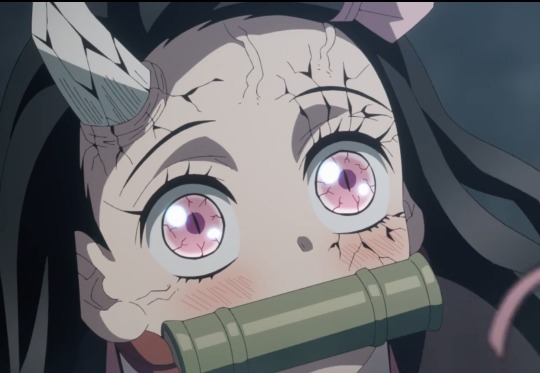
"The Oni has come a long way from being a feared and terrifying creature who threatened the lives of Japanese to one who represents a vital finalcial resource. These days there are even gentle oni, and cute and secy ones. The transformation of Japan's own socieo-economic change [...] Some aspects of the Oni may be emphasized more than others. Furthermore, oni can be used as art objects, or exploited as political weapons. But whatever the means, oni have been always na important part of the japanese psyche, and continue to be so." - Reider, 2013
CARTER, Caleb. 2019 - The demonic countryside: beckoning early modern visitors through oni legend and ritual. Japan Forum, 31:4, 467-486. <https://doi.org/10.1080/09555803.2019.1594336>;
REIDER, Noriko T. 2010 - Japanese Lore: Oni from Ancient time to present. Utah: Utah State University Press. Ebook;
REIDER, Noriko T. 2003 - Transformation of the Oni: From the frightening and symbolical to the cute and sexy. Asian Folklore Studies, Volume 62, 133-157. Ohio: Miami University. <https://www.jstor.org/stable/1179083>;
#demon slayer#demon slayer from history to fantasy#demonslayerfromhistorytofantasy#history#history research#japanese history#demon slayer history#kimetsu no yaiba#urusei yatsura#lum#oni
3 notes
·
View notes
Text
Recent-ish TV/movie reboots I’ve watched:
- Arrested Development: Controversially, I thought season 4 was a work of art. Not the same thing as the first three seasons, but something else that was really good. The way everything started out of place and then fit together perfectly like a puzzle, the way you didn’t just get more out of it on a second watch, you were basically watching a whole new show because you had all the context. But then, I am really into things that fit together like a puzzle. In terms of pure comedy… it was good, not quite up to the standards of the first three, but to be fair, those are ridiculously high standards.
Season 5 was good too, and I was happy to have it, though I did rather like the narrative poetry in the idea of the whole show ending on Michael Cera finally punching his dad in the face at the end of season 4.
- Cobra Kai: So much fun. Okay, maybe not technically the best show out there, maybe technically a high school drama. But it’s so much fun. And gets a few things surprisingly true-to-life that I rarely see on screen, like how cycles of abuse work in coach/athlete relationships (God, the number of times I’ve been told to forgive the high school coach who treated my teammates and I like shit because his coach fucked him up first, there are solid bits of drama for TV shows there that so far have been mainly covered by Cobra Kai and The Mighty Ducks). But aside from that, it’s just done well. I love the way they got back nearly every significant actor from the original movies. The way they took the characters to places that felt like they made sense, weren’t exactly where they were before but weren’t wildly different either, it seemed like a logical progression. The balance of old characters with new ones. And the way they have fun with working in stuff from the movies. It’s great.
- Veronica Mars: The movie was okay. The fourth season was, in my mildly controversial opinion, pretty good. It didn’t live up to the standards of the first two seasons, but few things do, including the third season. Season 4 looks pretty good if you don’t see it as coming off the back of seasons 1 and 2, but instead remember that season 3 existed, so the reboot left it on a better note than that. Season 4 felt more true to the original characters than season 3 did, and it had better explanations for stuff. Also a lot of people got mad about the ending but I never liked her with Logan anyway so that was fine.
- Party Down: Fucking awesome. I finally watched this one recently, which is what prompted this post. I first rewatched seasons and 1 and 2, which reminded me of how very, very good this show was in the first place. And season 3 lived up to that, which is more than I could have hoped for. They found a way to keep around the old characters without changing the setting or keeping them stagnant. To let them grow but still be involved in this thing they were doing years ago. That is a tough needle to thread, given the original premise, and they did it so well. It felt like no time had passed, like all the actors and writers were excited to be back, like everyone still had passion for this. They brought in new characters who were funny in their own ways and it all felt natural.
- Toy Story: God, such an unnecessary reboot, just leave the old classics alone.
…Just kidding, obviously. Obviously. The third movie was magic and beautiful, it grew with the original audience without compromising the childlike wonder, the fourth didn’t quite live up to the standards of the third, but still good.
I might be forgetting something, but I think these are all the reboots I’ve seen, and given that, my personal view of rebooting old series is that it’s not nearly as bad as its reputation. However, I’m pretty sure I just got lucky in not seeing the bad ones.
5 notes
·
View notes
Text
Paramount City: Favorite Characters
Master post.
They say no parent should love one child over another, but that's why I'm not parent.*
So my favorite character I made from each faction. Disqualifying leaders, otherwise it'd just be a list of them.
Defenders:
Intellectus. Really sets the stage by making the Martian Manhunter a refugee from New Phyrexia. How did he get here before the Omenpaths opened up? That's a good question that I will never answer.
Underground:
Jack O'-the-Harts. It was a tough call because Anemia is pure gritty 90s cheese (fun fact: her name is because all the other heroes were hogging the "blood" names), but Jack is just great. They're a twist on the Spider-Man archetype, but with such a different vibe you might not even notice. Also, making him an elf and elves tied to faeries led to the whole King Mob thing. Finally, led to some excellent worldbuilding ideas re: elk.
Breakers:
Malvorius. This one was an even tougher call because this is my favorite faction overall. I'm giving it to Crime Dracula though. I literally just came up with the idea on the fly but the idea was so crazy I'm surprised I can't find any comic character similar (The Shade, maybe?). They're a Dracula that does Crimes, but they don't do Dracula Crimes. Just regular Crimes, while being a Dracula.
Council
Seersha Sparks. Based on an old OC of mine, the idea of crimes as performance art isn't entirely new. But she is a bit different because she's way, way more dangerous and cunning than she comes off as. Imagine if the Joker was a woman and was into pretentious performance art instead of comedy, and you've got the idea. Her name is an example of the way I'm avoiding Anglo-Saxon phonemes and instead using Celtic or Welsh-based personal names. I can't remember how the name is originally spelled, but here it's written phonetically.
Omega
Latro. I should probably go back and edit in more of a physical description, as it's basically a monochrome Deathstroke. I also fucked up and listed it as UW when it was meant to be WB. I was kinda burning out towards the end. Anyway, its name is based on a Roman board game, and can mean mercenary, soldier, highwayman, or pawn. It's a pawn, but it could get promoted if it reaches the end of the board. I like the idea of a robot programmed with literal black and white morality that acts as a neutral arbiter. That could never go wrong.
0 notes
Text

#HARPERSMOVIECOLLECTION
2023
I watched Dogville (2003)
I'm a fan of director Lars Von Trier. If you're not, you probably hate being disturbed or challenged by controversial film artists. Which is totally fine, but I prefer my movies this way.
A small town is convinced to take in a woman named Grace, who is running from gangsters. Eventually the townspeople grow to love the woman, but as the search for Grace grows, relationships begin to change.
I love the very idea of this film's execution. The entire movie is set on a soundstage which represents a town, with minimal set decoration and chalk outlines in the stead of buildings. Along with Von Trier's wandering handheld camera style, the whole thing is a master class in why stage plays, and simpler film executions, can be just as immersive as any other version of storytelling.
The film features and excellent cast led by Paul Bettany, Nicole Kidman and Stellan Skarsgard. With a enrapturing narration from John Hurt.
Thanks to my grandmother, I grew up going to the theater and seeing plays as they came through my city. I developed an affinity for them, especially the smaller productions, which rely mainly on actors and storytelling, rather than grand sets and big musical numbers. This film is right up my alley in every way, mainly because of this.
I suppose I could see how some people wouldn't have a taste for this film because of it's execution. You have to enjoy stage plays. Long stage plays at that. This is a three hour film, with good pacing but a slowly developing story.
It's also a descent into darkness, which almost breaks your heart as you want everything to work out and everyone to be kindhearted. Lots of people don't like depression and brutality in film, but I'd argue that every aspect of human life should be captured and experienced through art.
As a filmmaker, Lars Von Trier deals in darkness and brutality. His is a career of brutal films, depressing films, violent films and sometimes even comedy spawned out of pure evil.
For me, what Von Trier brings to the table and what he does best is tell character driven stories. He does this while seriously challenging his audience to bear the experience which he puts them through. He conjures emotion, even if that emotion is fearful, disgusting or depressive.
When the turning point comes in this film, when you realize things are getting bad for the character of Grace, you start to realize that these people don't really care about her. Even the seemingly kind and helpful Tom shows some true colors, that he wants more than Grace's safety and happiness. The less Grace becomes a benefit, the less the town cares about her. The more leverage they get on her, the more they abuse her. Suddenly you realize nothing has been done for Grace out of kindness. Deep down it's all been selfish. Dogville gets very dark, and it can surely be perceived as a film that has no faith in true selflessness.
During the film, Grace continues to buy porcelain figurines, and as things turn bad they are eventually shattered before her, causing her to break down and cry. This, to me, is the main moment of the film. The porcelain dolls represent Grace's view of Dogville's small town perfection. When they are smashed she finally sees Dogville for what it is, and we see these people for who they really are.
This is really a great film, which made me sick to my stomach. I found Grace's predicament nightmarish and difficult to watch. I was so frustrated and disgusted by it, I actually became a bit angry. I have a feeling that's why some critics can't stand it. But, the film is meant to upset its audience and it does so effectively. Even as it leaves us and Grace changed for the worse. Excellent.
0 notes
Text
“The Feminine Ideal” : paintings in the cinema part 2/4
If in the last article, Kate, one of the main characters of Dressed to kill identifies herself with the portrait of Alex Katz, in this article I would like to write about a character that embodies a portrait. In many movies like Titanic by James Cameronor Renoir by Gilles Bourdos, painters make portraits of nude women who model for them. This practice is as old as the history of paintings and its staging in movies is also a common practice when it comes to films about painters or artists. Nevertheless, I would like to write about a painter that made a portrait about a girl that he never saw. The portrait The Feminine Ideal by Maxence, the poet-paintor soldier in Jack Demy’s film The Young girls of Rochefort, is one of the main characters of this musical comedy about finding love. This portrait of an unknown women is incarnated by Catherine Deneuve as Delphine Garnier.
In Dressed to kill the women is confronted to the painting and the act of observing provokes mixed feelings for her. In The Young girls of Rochefort, Delphine is puzzled by the resemblance between her and the women in a painting exposed at her ex-boyfriend’s gallery. Her ex-boyfriend Guillaume thinks that this portrait is not about Delphine because for him it’s a figurative painting and Delphine is more than that, she is a spiritual being. For Guillaume this is a pure imaginative artwork without any significant value. However, the resemblance is undeniable.
Maxence, the painter, is searching for this women all over the world but his quest seems to be unreachable and pointless. For Maxence, an abstract painter that made his first and only figurative painting, this woman exists purely in his imagination. Although he’s convinced that she can exist in real life. In Maxence's head, this woman already has a name, a voice and a face. This imaginary woman has golden hair, an innocent glance, a silhouette that resembles to “mythical creatures that haunt museums and adolescents” and a way of walking that reminds him of some childhood memories. This imaginary women, this “ideal” its purely an intellectual model, an artificial being who seems unreachable.

The Feminine Ideal reverses the relationship between the painter and the muse and between the figurative painting and reality. Here the pictorial imaginary precedes the reality[1]. For Josephine Jibokji Frizon, the portrait made by Maxence imitates Bernard Buffet’s style characterised by portraits without any smiles and disembodied silhouettes. For Maurice Druon, Bernard Buffet is an artist haunted by the need to impose his vision of the outside world[2]. This corresponds exactly to what Maxence is doing with his painting of an ideal woman. Throughout the whole movie we think that this ideal model is Delphine but actually the only real resemblance is a physical one. In fact, Delphine claims to be something more than an objet. She says to Guillaume that he considers her as a doll and he neglects her way of thinking, her feelings. She doesn’t even understand why Guillaume loves her since, in her opinion, he doesn’t really know her. We could say that Maxence, as an idealist, is also reducing this “feminine ideal” to that, an idea, and Delphine or any women is more than an idea, more than an objet, they are complex human beings.
What is beautiful about this movie and the choices of Jacques Demy is that the meeting between Maxence and Delphine is never shown in the movie. We can understand this as an invitation to value ideals and dreams in art but also to acknowledge that what’s important is the path and not the ideal itself. The Young Girls of Rochefort is a beautiful film even if the characters only meet at the very end of the movie.
Laura Cárdenas.
[1] Joséphine Jibokji Frizon, “La peinture en fiction. Expériences artistiques et amoureuses dans la galerie de peinture des Demoiselles de Rochefort”, 2015, p.100
[2] Ibid
0 notes
Note
Sending this before I forget lol it's Worldbuilding Wednesday again so uhhh we've talked about Val and his books before, but what about other prominent authors? Talk media to me today June. What kinds of media exist?
Hey dude.
This is a fun question! And not something I think about often but also not completely nonexistent in my settings. Since we're talking Val, I'll stick mainly to ORG/TSS.
In a now scraped chapter of an older OBS draft, Enyo dresses up as a bumbling, foolish character from an Oskyan ballet as a subtle slight to Prince Aayden. Which 1. implies that Enyo, who has never left Graza, would have either seen an Oskyan ballet or 2. that this ballet is likely based on a novel or something that was translated which is gonna be the theory I work with as King Frederick did have an entire section of the palace library dedicated to Oskyan literature given its what he grew up with and he was fond of it.
Valera himself was inspired by a dead Escana Poet (from whom he borrowed his name). And before him, there was Rusnak who wrote more "utopian" fiction than Valera's model of "this is what's wrong with the world" so his work has mostly survived book bans and burning. At the end of TNC, Mikolaj and his friend Andrzej talk about a series of "books" in which an Ulra man kidnaps a man who is either Gegraen or Oskyan (depending on which copy you pick up) who is traveling to become an in-house tutor but falls into a series of licentious debauchery. They don't know who the author is and there's likely more than one as the story slightly changes based on edition and language.
I am sad I didn't talk enough about ballet or opera in TNC tbh. Olaf has a great love for both and I do try to hint that he has a bit of a dance background (Mikolaj blatantly says he has a dancer's body) and the same rings true for Justyna as her mother used to be a professional dancer and she has a background in music. She's the only one in the cast who casually names composers and I think she'd enjoy taking them to art galleries. Mikolaj has also, during the height of his popularity as a courtesan, been gifted several priceless paintings. But dance and storytelling through dance is something that's important to all of them whether from a strict cultural standpoint (Ulra and rural Gegra have a lot of "folk" dancing) or purely as an art form and entertainment it's the biggest thing the 3 of them have in common besides anything else.
The theatre is thriving (in the background). Argus talks about there being several plays inspired by his father's colorful life but the Escana are also dramatic people so they tend to love stories with high-stakes romance and a lot of campy moments (a play Leonides watches in his prequel involves a lot of sword fights, cross-dressing, love triangles, and tragic deaths that come with long monologues and this is considered the norm for an Escana drama). This is mostly because during King Frederick's reign, he loved laughing so the Escana leaned more towards comedy and over the top and he could quite the brutal critic if he didn't like something. There are a handful of "newspapers" (that's not what I call them) that are published in Graza and one of them does not have the official approval of the palace so this is the one you read if you want to see unflattering political cartoons or crass jokes.
0 notes
Text
A lot my answers will be dependent on what game they come from as that also informs a part of their life and history, so whatever genre their home game has, that's gonna be a part of my OC as well.
Also, as a personal bias, I'm going the anime route rather than live action for all of them. Because, again, personal bias. It's what I'm going to pick given the choice.
Houki
As a transplant MC from a political drama strategy-style game to IkeSen, her show would be a political drama that eases into a historical war story with a sprinkling of isekai, technically speaking. If I'm putting her in an anime style, I'd want it with an author that has shown respect to different body types before (given that Houki is plus-sized) so I'd want Hiromu Arakawa (Full Metal Alchemist) or Ryoko Kui (Dungeon Meshi) style to do her justice.


Ophelia
As she's also from the same game and goes to the same game as Houki, she would also have elements of a political drama plus a historical war story, but with more emphasis on the darker elements and family drama. I think she'd do well in a late 90s, early 2000s style anime, closer to realism but with more grit to it. Stylistically speaking, I was thinking of inspo from the Twelve Kingdoms with that early 2000s grit and fantasy realism for her.

Thea
I can see her with romantic comedy anime with a sprinkling of the supernatural (because vampires, duh), given how she and Theo bicker sometimes, tsundere vs tsundere. Rumiko Takahashi's style (Inuyasha, Ranma 1/2) seems like it would be something that would suit her well.

Abby
Abby's story I can see as a slice of life drama with some sprinkling of the supernatural (because vampires, duh). If I was to pick a style, I'd with Mamoru Hosoda's style of direction (Wolf Children specifically) with the way he handles slice of life family drama.

Maddie
Maddie's story is literally Alice in Wonderland with a war story sprinkled in (but not Tim Burton's version with its lack of the Burton Aesthetic✨). And I did say I was mainly gonna focus on anime style, so for Maddie's style, I'm going with Vision of Escaflowne. It's a mid-90s fantasy anime where a normal girl goes to a fantasy land and tries to find her way back home in the midst of a war going on. Cradle seems like it'd be too small of place to hold giant robot fights though, no matter how cool I think that'd be. Oh well.

Clara
Clara's story is very medieval fantasy with political drama and a war story added in. With that in mind, I'm going with CLAMP for her story's art style, specifically Magic Knights Rayearth, which is a story about a tiny kingdom on the brink of collapse, but with the help of some pure-hearted souls, they help to restore the kingdom (by becoming part of the system, whoops). Also, do you think IkePri could be improved with giant robot fights? It would certainly make Obsidian a lot more terrifying even with their guns.

Miri
Obey Me already has its own anime but it's more of a series of episodic adventures rather than as one long narrative, so if I wanted it as a cohesive narrative, Miri's adventures is definitely more on the supernatural side with found family as main focuses with a sprinkling of magical girl. As for an anime style I'd want it to be in, I'd go with Shinichiro Watanabe (Cowboy Bebop, Samurai Champloo)'s style. Very stylish with just enough grit to not make it a squeaky clean fashion show, plus major themes of found family despite rough circumstances.


If your OC had their own anime/TV show, what genre would it be?
Check pinned post for event details.
#answered asks#houki of jiyel (oc)#ophelia of revaire (oc)#dorothea reid (oc)#abigail clarke (oc)#madeline fleming (oc)#clara laurent (oc)#miriam (oc)#don't ask me about how much I want to do style translations for my girls and their respective games into these styles#or that I'd wanted to do everyone in the escaflowne style#because I have neither the time or knowhow to do this#any of it#I'm sure as hell gonna imagine it to death tho
9 notes
·
View notes
Text
Sabikui Bisco Volume 4: Karmic Crown, Florescent Sword

So I was thinking of writing out my thoughts on this volume yesterday, but there was just stuff in the back of my head that didn't really line up. Pieces that wouldn't fall into place, so to speak. For the uninitiated, Shinji Cobkubo writes each volume of Sabikui Bisco with a (typically) single word theme, this volume being "rules".
It took me a bit to wrap my head around, but Cobkubo really does stretch the concept of the theme. Societal rules and systems, upspoken rules, even laws of nature. It's incredibly far reaching, and really does account for some of the more curious pieces of the volume.
Regardless of theme though, I'm so helplessly drawn in by Cobkubo's writing style. The fights are so electrifying, the drama so intense, the comedy rolling off the tongues of the characters effortlessly. Sure, it can stand to be a little literal with what it does, and the combat is purely relative. But, I think it's far more enjoyable approach that suits Cobkubo. There's no worrying about scaling, there's no concerns about trying to make stuff "believable", Cobkubo just gets to write about kickass stuff from start to finish.
Also, I'm still in love with the light novel art style. I really love how messy and sharp and stylized it is.
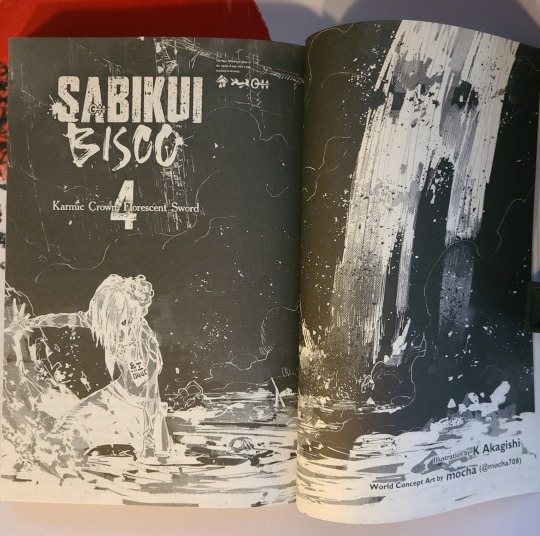
Pivoting to more specifics of this volume, I was a little concerned at first with how things would work out. We were coming off the tail end of the "original" end for Sabikui Bisco, but Cobkubo found a worthy enough continuation of the story all things considered. Bringing in the concept of other genetically altered beings, though originally meant for labor and slavery, was a good angle and keeps things rolling off the biotechnological beat we've been rolling with. It also seems like it's starting a new leg in the story overall, moving past the single volume approach we'd seen in the previous three, so I'm very curious to see where it all ends up.
In between that all, I was curious to see how much Cobkubo would bring up previous endeavors with Bisco and Milo. At the start there wasn't much, but the further that we got into it, the more they came to the surface. The biggest thing being Milo's rust powers showing up again, because early on I felt like it was a pretty important thing to neglect. The same can be said about Bisco's Rust Eater powers, but similar to Milo's, they serve a very specific purpose in the volume. Both effectively take a backseat to the genetically altered people, the Benibishi, and their unique abilities. It might take some getting used to, but the Benibishi are definitely the main focus of this volume, so Bisco and Milo's... roles, so to speak, are different from what they were before.
So sure, we've seen supporting characters that have important roles like Amrini Amuri from Vol 2 and the Bloody Battle with Lord Kelshina or Tirol in vol 3, but this is different. It's not the supporting piece, it's the core piece. Shishi, the effective main character of this story, comes to Bisco and Milo very early on, and in fact we start this volume with them. It's very interesting, and their entire appeal and purpose continues that feeling. It's not quite that Cobkubo has a different writing style, but more so a different perspective of the world now. That now that Bisco and Milo have saved it, they're able to extend the reach of their stories and lives, and experience even weirder and crazier stuff, and I'm here for it really.
Sabikui Bisco is at its best when nothing other than the moment matters. To quote Cobkubo himself,

Chaos, creativity, and curiosity are Cobkubo's greatest weapons, and as the world expands beyond his initial vision, we're seeing those tools continue to get sharpened, to carve out even more elaborate and eccentric stories and ideas. And at this point, the sky's the limit with what Cobkubo could want to do.
#sabikui bisco#rust eater bisco#bisco akaboshi#anime and manga#light novel review#light novel recommendation#light novel#shinji cobkubo
17 notes
·
View notes
Note
I have never been one to think that acting seems like a fun job, so I’ve never been one to think much about whether the actors in these series are having fun with their characters or what characters I would want to play. However, I think Choc Milk Shake is the first series where I’ve thought “oh that would be fun to act in.” The actors for Choco and Milk portray cat and dog turned human so well that I can’t help but imagine the actors were having a blast on set. My question is, do any other characters/roles come to mind that you think the actors probably had a ton of fun getting to portray? Or any that you personally think would be the most fun to portray if you were an actor?
BL Actors Having Fun With Their Parts

Hilariously that was the first thing I thought in the first episode: the actors playing the cat and the dog must be having such a good time.
I think with some of the other roles that might spring to mind, it kind of depends on the personality of the actor and their costars and the rest of the cast. Also, we as viewers tend to make the mistake of assuming that comedies are more fun to act in than dramas or horrors. When in fact, it's often the opposite, comedy is most challenging on actors.
However, knowing that, and going in under the auspices of pure speculation...

It's obvious that the whole cast had a really good time filming I'm Tee, Me Too. I think that for all its seriousness, the GMMTV boys probably had a really great time on the set of Not Me, and probably the Eclipse as well. On the other hand, while it's one of my favorite Thai BLs, I think you can tell that it was a really tough and taxing location shoot for ATOTS.
In terms of actual parts?
I think Seng seemed to have fun with Toh in SCOY. In Thailand in particular, especially if the pair is familiar and relaxed with each other, I think they probably just enjoy the working experience more. I'm thinking about pairs like MaxNat, who just give the impression of being fun and breezy on set. Or an actor like Perth (My Engineer) who everybody else just seems to enjoy being around.
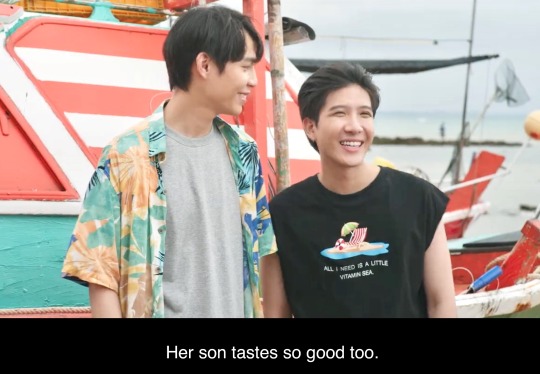
Also actors tend to enjoy something that adds to their range. So if they've typically been typecast in one role, like Khaotung was prior to The Eclipse, it's fun for them to get to play something completely different. I think we can usually see that when it happens. The actor is just sparkles more when he’s into the part.
Sometimes when an actor is handed a taxing physical role, and is particularly into fitness, he ends up really enjoying it. Like parts that come with fight sequences, or martial arts. Quite a few of the boys in KinnPorshe had more than their fair share of fun in some of those fight scenes. Like it tapped into their little kid sense of playing cops & robbers. Even knowing fight scenes are incredibly hard work.
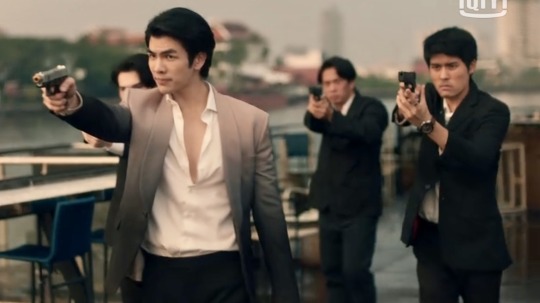
I get the feeling the set of Trapped was a really good time for all. I think Chris and Jake both seem to be having fun with their roles, another cops & robbers thing. Similarly SCI.
Some of the Japanese super slapstick leads spring to mind. I think if you have the right personality to portray physical comedy, you can probably lean into it. I get the impression that Nakao Masaki is really enjoying playing Issei (Kabe Koji), because it's the polar opposite of every role he's ever been handed before.
It seems like Takara & Amagi was a difficult set, while Old Fashion Cupcake comes off as probably quite easy - working environment wise. That just means that in the second example, everyone on set is likely to have a bit more fun, including the actors.
It seems like both the leads in Word of Honor were having a blast most of the time.

The Korean actors are much more difficult to read. I think it's easier to tell when things were more challenging on set than when the actor enjoyed the role. Color Rush, for example, comes off as an extremely formal, even stiff, working environment. Where as Semantic Error and 304 were (what amounts to the) Korean version of relaxed (which still isn't very). And Ji Sung is clearly having the time of his gd life with Devil Judge.
All that said, these are actors. And with the best actors it's really hard (if not impossible) to tell how they feel about playing a role, because they are inhabiting it. This is one of the reasons I get annoyed if I can sense that the actor is uncomfortable with telegraphing gay chemistry. It means either that they're not a very good actor, or something about the set culture, director, and/or filming environment is making it difficult for them to fully inhabit their part.
Thanks for the thought provoking question. (Sorry I couldn't tackle the second part of your question, of all the careers I could have in the universe acting is very near the bottom of my list.)
(source)
#asked and answered#filming industry#thai actors#korean actors#taiwanese actors#Devil Judge#Semantic Error#HIStory 3: Trapped#taiwanese bl#thai bl#korean bl#Word of Honor#Old Fashion Cupcake#Kabe Koji#Nakao Masaki#KinnPorshe#The Eclipse#I'm Tee Me Too.
166 notes
·
View notes
Text
I know this said in the tags but also…I have too many to really count so *sighs* I’ll put my whole rec list here since many of the manhua I’ve added are ones I adore ahaha:
The biggest stars though…:
When it comes to more general stories and ones that have gotten donghua (animated) adaptations, I’m obsessed with White Cat Legend, Beryl and Sapphire, Fei Ren Zai, Lanxi Zhen, and All Saints Street.
White Cat Legend is set in the Tang dynasty and is all about mystery and intrigue, with the donghua adaptation showcasing a lot of incredible action scenes. We also have a main character who is…a literal anthropomorphic white cat due to ~mysterious reasons~ from his past, and it’s a really intriguing one to slowly unlock.


(^ Also all of these characters in the above gif are great)
Beryl and Sapphire is really fun because it’s only drawn in stick figures—even though the characters do have canonical human designs—and can tell a different story every chapter. Some are overarching arcs the author cuts back to, like the Robo-Beryl and Demon King Beryl arcs, but many are just one-off stories. The donghua handles this by having the first season treat the main characters, the titular Beryl and Sapphire, as actors, which you can see in the catchy OP:

It’s a really unique yet adorable experience!
Fei Ren Zai is more slice-of-life, goofy fun, with the main cast being legendary and mythical Chinese creatures (yaoguai and yaojing) and figures (such as gods and goddesses). The twist here is that they now all live—and have to navigate—the modern day lol.
This one updates a lot and thus has many, many good jokes, and even educates people on Chinese mythology a bit through its comedy—you can thank Baize for that, the fourth wall-breaking bookworm who also hosts a trivia segment after many episodes of the donghua.
The entire cast is really charming for this one, and it has some of the best merch out there!

Similarly, All Saints Street is the exact same premise, except featuring Western monsters. It’s also Fei Ren Zai’s sister series, and I’ll always have a soft spot for it and Lanxi Zhen since I was a contributor to my friends’ efforts to translate these manhua.


(^ Lanxi Zhen is also the prequel manhua to the donghua, The Legend of Luo Xiaohei, and its prequel film, The Legend of Hei, which became popular a few years ago due to its gorgeous animation. I’ve connected it here to All Saints Street since both are series I’ve helped translate, but also because the director of Luo Xiaohei, MTJJ, also directed the animated adaptation of All Saints Street.)
Now for shoujo—or in this case, shaonü—manhua, I adored both Once More and Protect My Star due to the maturity they showed behind their themes. I also really like Hidden Love since it’s both cute and because the cdrama adaptation was so so good, which is actually why I intend to read some more shaonü manhua soon…
What I like about them is that we don't always get flat female and male leads or the more stereotypical "I'm a goofy nice girl who falls for the bad boy/boy who's kind of a troublemaker/mean to me" character tropes (which there's nothing wrong with! I myself loved many shoujo manhua with such character settings as a kid).
The male leads for these ones are really goddamn charming and the romance is all so soft. They also have very nice art styles that disprove many manhwa readers' assumptions that Chinese manhua always look "bad" or are "poorly written."
To quickly summarize some selling points: Protect My Star starts off as a goofy "fan ends up with idol" story that on the surface looks like pure wish fulfillment—especially since some readers found issue with the way the main character treated the idol of the story—but it's actually a great set-up for growth that really pays off. This applies to the side ship as well, who have their fair share of issues, but also reach a point that many fans appreciate, and I can't help but also cheer on the male lead of this side couple ship, since he's a classic puppy dog character ahaha. But yeah, all the relationships and characters develop and grow in ways that are pretty fulfilling in this manhua, to the point you can really feel as if the characters have grown up by the end of it!
Hidden Love and its sister series, First Frost (or brother series, since the male lead there is the brother of the main character of Hidden Love), are also just really lovely. Hidden Love is a schoolgirl's romance: a girl falls for her older brother's friend and even though she does miss him due to him only seeing her as a little sister, an unexpected reunion when she's in university sets off a romance that took the world by storm when the cdrama adaptation released (Duan Jiaxu, the man that you are...). It's just really sweet and does have a very beautiful—and cute!—romance, where the male lead actually finds healing in the female lead.
Then for Once More, there's a maturity to it that feels pretty new. Like we do get misunderstandings and the characters do make stupid mistakes, but they tackle the issues and communicate the way adults should. It also explores a lot in terms of what makes a romantic relationship and how backgrounds—and trauma—can create boundaries that couples have to navigate together. The male lead is also really compelling in this one! He's soft and gentle but playful and occasionally firm, and the way he pursues the female lead is really refreshing. Plus the side ship is cute too!!



There’s quite a few shaonü manhua in my donghua/manhua recommendations list and I have a feeling I’ll like quite a few of them, such as My OTP Is So Sweet That I Want to Fall in Love and My Star and I, aka My Lucky Star. Even without having read them yet, I'm already really charmed by their art styles, which has a watercolour-y feel to it that I've picked up is pretty popular in these shaonü manhua! I've also checked them out a little bit and like the three shaonü manhua I described above, My OTP Is So Sweet and My Lucky Star also seem to contain pretty compelling stories with gentle romances and character development, with the male leads all being quite charming.
As for a shaonü manhua I really like with a donghua adaptation, the body-swap story, No Doubt in Us, is a great one, and its writer is even behind the popular danmei (boys' love) novel (which also has a manhua), The Wife Is First.

Now if we were to switch gears to the ones that I go really feral over... They're admittedly danmei/boys' love manhua ahaha.
The biggest contenders and the ones that you could actually make a case are my "true" favourites are I Ship My Rival x Me and Kiss the Abyss. The former is based on an equally fun novel with an equally hilarious audio drama adaptation, and the latter is an original manhua but has a really great vomic adaptation.


If I were to explain the charm of the above two...
Well, the main characters for I Ship My Rival x Me are just refreshingly adorable, and the entire thing is pretty soft but also just very funny. Wei Yanzi's brain circuit makes a frightening amount of sense despite its zaniness, and I don't think anyone can fault him for falling for the charming puppy and greenest of green flags to ever green flag, Gu Yiliang. They also both make some really stupid assumptions that lead to some really stupid but actually really harmless—and thus hilarious—misunderstandings. 😂
This manhua literally fulfills the age-old imagination of fans who end up shipping their favourite actors together—as the entire reason Wei Yanzi and Gu Yiliang get together is because Wei Yanzi starts shipping him and Gu Yiliang too...except he's only shipping it ~in theory~ because their fans (who call them the Niangzi ship) are the only ones who don't view them as rivals! Wei Yanzi totally doesn't actually have a thing for Gu Yiliang himself...right?
(Spoiler alert: he totally ends up having a thing for Gu Yiliang 🤣)
It's just a super feel-good and squee-worthy story, and the manhua's art style and pacing are all so *chef's kiss*. The manhua has an adorableness to it that's perfect for this story.
In contrast, Kiss the Abyss is darker, as our main character—and my personal gender envy icon—Wang Zixin (aka Wangzi or "Prince") transmigrates into the video game he made after being killed by its main character come to life...and the video game features a death game (think Squid Games) that its players must survive. In comes the very main character that killed Wangzi for putting him through such hell, known as Abyss, an experiment of super-strength that has only known a lab his whole life, except now he's a teenager who hasn't yet darkened to the point of no return or suffered the very death game that made him snap.
So thanks to a pretty absent System—a popular trope in Chinese transmigration stories that control things like a video game and hands the transmigrator protagonist tasks—Wangzi has to protect Abyss and make sure he doesn't suffer the same dark fate as the original Abyss.
I love this one because of the main characters: Wangzi is very smart and level-headed—but with both charm and humour—and a complete bi icon. He's suffered a lot himself in his past, but he picked himself up due to reasons we find out as the story goes on, and he's just a really interesting main character to follow. Then Abyss is very much so the puppy/wolf trope, which I fell in love with after reading both The Scum Villain's Self-Saving System and Erha. It's hard not to love Abyss when he has much of the same charm as Luo Binghe and Mo Ran from those other stories I mentioned.
Also, the author of Kiss the Abyss is behind some other manhua I really enjoy, such as the popular I Have to Be a Great Villain and the more underrated but still quite "darkly" interesting I'm Sick!
I've actually done some translation work for the Kiss the Abyss vomic here, here, and here.
Don't Say You Love Me is also another really cute one that I think I can argue as a favourite of mine—to the point I myself even translated some of the original Chinese chapters (for example, here), along with a few clips of its vomic adaptation (for example, here and here), to English lol. It's a time travel story (also called transmigration in Chinese even though the character doesn't transmigrate into another world/story): Lin Yutong is confessed to by his best friend, Qin Weiyun, and in a drunken panic, he runs away...only for Qin Weiyun to be hit by a car while chasing him.
This triggers his transmigration/time travel back to before they graduated high school, where he hasn't met the reticent but polite Qin Weiyun yet. They still meet, except now Lin Yutong has to navigate all these other things: living this period of his life over, his feelings for Qin Weiyun—and Qin Weiyun's potential future (romantic) feelings for him, the future accident, and so on.
Similarly, the aloof and distant Qin Weiyun is kind of on-guard with this Lin Yutong, who acts weirdly nice and open to and interested in him, and who seems to know him bizarrely well. To someone that prefers to keep everyone at a distance, Qin Weiyun finds Lin Yutong suspicious in multiple ways.
Still, this is a very cute slice-of-life story with a pretty refreshing romance between its leads, since Lin Yutong isn't your typical boys' love protagonist. He's silly and goofy and a bit childish, but it's exactly that sunny charm that draws in the seemingly cold Qin Weiyun.
Plus the author's other manhua, Beware of the Dream Demon, is also quite popular!

Pixiu's Eatery, No Way Out aka Pixiu's Bistro is also great! It's like Fei Ren Zai since it has mythical Chinese yao and gods in the modern day, but this one's a danmei. Our titular Pixiu ends up taking in a male ghost named Wen Xi who doesn't have many memories due to reasons™️, and a hilarious yet heartfelt romance ensues. I've also loved this one enough to translate a clip from its vomic as well here, since this scene in particular always gets me cackling when we reach it lol.
It's a very "we kind of need each other but we start off very unwilling" relationship that snowballs into a "we spend so much time together and help each other so much that no wonder we fell in love with each other" ship. And even if you know nothing about Chinese mythology, a lot of the jokes work anyway. 😆
But like Fei Ren Zai, this manhua similarly plays with the identities of these Chinese mythical beings and how they'd be affected—comedically—by the modern world. Like Pixiu, a creature of fortune, is now a penny-pinching, grumpy restaurant owner who bears a severe grudge against the mysterious Taotie.
I don't think I can really do justice for this one if I were to keep trying to describe it, since comedy often has to be experienced for yourself. But if you like danmei and/or Fei Ren Zai and/or Chinese mythology and/or comedy, then this is the story for you!

A few others that I really like that float between being known and unknown are How'd I Get a Heroine's Script and Wo Jia Dashixiong Naozi You Keng, both transmigration stories.
For the former, I like it for its cute, soft nature—and the way it plays with transmigration clichés. Specifically, we first meet Chao Yi, who transmigrates into a palace and is told he needs to get close to the polite and smiley but actually very cold seventh prince, Gu Yunheng...which means he does plenty of silly, "embarrassing" romantic gestures to try and get close to the reticent seventh prince.
Except throw in a few twists (there's one I really like that I won't spoil, but I think it's a "you'll know it when you see it" twist) and a mystery and some court intrigue, and you get a story that ends up a pretty endearing romance and interesting, if not understated, palace drama.
This one's also another one with a vomic adaptation too~

Then for Wo Jia Dashixiong Naozi You Keng, aka My Dashixiong Has a Hole in His Brain, it's a hilarious transmigration story that also involves reincarnation...which makes it like SVSSS and Erha kind of mashed together.
I wrote the Pinyin version of its name, which probably looks daunting for a non-Chinese speaker. And this is because its poor English name has been through a lot. For example, the donghua's official English title is just What's Wrong With My Big Brother, which I feel like misses a lot of the goofy and, of course, cultural charm of the original.
It's a little harder to recommend I think, since it relies on you being familiar with both wuxia (Chinese martial arts fantasy) and transmigration tropes: for example, our protagonist, Dongfang Xianyun, thinks he's just an NPC, so he lazes around for the first bit of the story while bothering who he thinks is the protagonist: Yin Feixing.
What he doesn't know though is that Yin Feixing is actually living this life over, having reincarnated. Because his last life ended so poorly—he became a demonic sect cultivator and was condemned by society, including his upright and stoic dashixiong (elder martial sect brother), Dongfang Xianyun... So in this life, he intends to push every bad thing that happened to him onto Dongfang Xianyun, including becoming a demonic sect cultivator.
What he can't foresee is that his dashixiong has changed a lot. Gone is the calm and collected dashixiong he came to see as a hypocrite in his last life. Now he's...weirdly goofy and shirks responsibility at every turn. At first, Yin Feixing is constantly yelling and chasing his dashixiong (classic tsundere behaviour lol), but his dashixiong's newfound warmth is weirdly off-putting in the sense that it lowers his guard...but also means that no matter what Yin Feixing throws his way, Dongfang Xianyun now seems capable of changing the narrative?
It's...admittedly a manhua that has a lot of fanservice, as it's not explicitly a boys' love/danmei story, yet it is very, very queer-coded. The original manhua also features costume designs with quite a bit of skin, and it's been going on forever.
I'd recommend it for those who a) like wuxia and transmigration already, b) who can enjoy and tolerate bl tropes and tones and fanservice, and c) who like the premise I just described above.
If you are intrigued but can't necessarily handle a manhua that's hundreds of chapters and not even fully translated and has those bl/fanservice overtones, I'd recommend the donghua adaptation instead! It's 3 seasons so far, and it tones down a lot of the fanservice, but still retains much of the other things, including its hilarity and its charm.
Oh, and the donghua's seasonal titles are really clever and cute, since it presents the series' narrative arc within itself!:
Season 1: Wo Jia Dashixiong Naozi You Keng: My Dashixiong Has a Hole in His Brain (the title of the original manhua and its title overall)
Season 2: Wo Jia Dashixiong Shi Ge Fanpai: My Dashixiong Is a Villain
Season 3: Wo Jia Dashixiong You Dian Kaopu: My Dashixiong Is a Bit Reliable

Final one I wanted to showcase is The Silver Wolf...because it's really fucking cute and I really like it but no one knows about it!!
If I had to promote it in a way that generated interest, I'd liken it to The Legend of Luo Xiaohei—which I have before—since both feature a young girl with pink hair taking in a boy who's actually a yaojing. Both boys thus have animal features (cat and wolf ears!) and both girls also have mysterious "older brothers" who are related to the world of magic somehow.
Specifically, for those who like The Legend of Luo Xiaohei and actually ship said pink-haired girl with said-yao boy, while Luo Xiaohei doesn't exactly make that romance canon, The Silver Wolf does!
Its romance is admittedly very subtle, and this can be counted as a great series for younger audiences as well, but I still really like and recommend it due to its very nice art style, its dynamic action scenes, its compelling writing for the characters and plot and relationships, and because it's as cute as it is interesting~

I also didn't mention a lot of girls' love aka baihe manhua since I admittedly haven't read as many of them, although Straight Girl Trap and Baili Jin Among Mortals and Tamen de Gushi are really cute. I've been meaning to check out more as well! For example, the dark I'm More Dangerous Than You and the popular Miss Forensics are both series that have gotten my attention. I've also noticed quite a few baihe manhua take place in the entertainment circle genre, which is a genre I like!
And man, I could just keep going and going and going...
Like right now I'm really enjoying a lot of manhua, including See You My King; Blemishing the Contaminated; The Film Emperor, He Insisted on Being My Patron; The Trapped Beast; It’s Not That I Want to Wear Women’s Clothing; Salt Friend; and many others. Quite a few of these are ones that are actually adaptations of existing danmei novels, such as the mental health-aware Jie Yao, the police story Poyun and its sequel, Tunhai, the beautiful Little Mushroom, and the thrilling Bing Xing Xia Deng (commonly known as Inferior By Nature but also The Selfish Gene).
For Bing Xing Xia Deng, the manhua is how I started it, but I'll admit if you want to experience it best, the original novel and its amazing audio drama adaptation on MaoEr FM are the ways to go—I'm kind of obsessed; especially since the audio drama adaptation adds a few short scenes from the male lead's POV that don't exist in the original novel, which is both first person POV and stars an unreliable narrator.
But I'm getting off-track. I will say though that Little Mushroom's manhua is actually a great way to experience its story (so far, at least!), if only for its super, super stunning artwork. Of course I'd still recommend the original novel (and it also has an audio drama adaptation!), which its fans also adore to death, but we almost lost the Little Mushroom manhua artist due to them originally wanting to give up after dealing with haters, but thankfully they stayed on and we now still get to enjoy it as is!

So to end this long ramble of a reblog off, I'll include my list of more boys' love (danmei) and girls' love (baihe) manhua!:
While I can't necessarily list all of the ones I've mentioned later as my favourites, like not every manhua in the danmei/baihe list is in my "top ten," many of them are still stories I enjoyed a lot and do recommend!
What's your fave webcomic?
5 notes
·
View notes
Text
28 Bloody Nights CAS Challenge #19 - Servant

Regen: Viktor!!! Prepare me a glass of Cabernet Sauvignon! Answering all those questions for the boy has really tensed me out.

Regen: Mmm, an excellent red. I can’t believe my offspring turned out to be such a wimpy little thing. Must’ve been her genetics that sullied the mix.
Viktor: Would you like me to get rid of them, sir?
Regen: ...Not now. If they keep bugging me, I might consider it. Perhaps I can find some use for them later down the line.
Viktor: Perhaps we could train the boy to become stronger? I could teach him about the Dark Arts, maybe introduce him to the torture chamber-
Regen: Viktor I know that sort of thing was fine in the 1400s but he’s a minor. At least wait until he’s 18 for God’s sake.
Viktor: ...How long til-
Regen: You know what forget what I said. Don’t ever bring Daniel to the torture chamber. Ever. God you are one messed up little buffoon.

Viktor ‘Igor‘ Madder is a relatively old vampire who once served on royal courts. He’s done everything from being a butler to caring for children to gardening. But in every role he’s played, he’s had a secondary role serving as a guard and assassin. Nobody ever suspects the butler right?
He used to disguise his more monstrous features, but Regen encouraged him to give it up, as he ‘wasn’t that attractive no matter which form he took anyway‘. Viktor is a sadomasochist and enjoys pain and suffering. He claims its the only thing that he really ‘feels‘ anymore. Living with a mad scientist allows him to explore news ways of exploring this side of himself.
Regen sometimes refers to him as ‘Igor‘ because he ‘looks like a moronic lab assistant who can’t do anything right‘. Its mostly used when the two are about to do work in the lab or torture chambers and Viktor wears it almost like a badge of honor. Regen’s relationship with Viktor is purely non-romantic: its all about satisfying their needs and urges. Its the same with any other victim person he meets or comes into the lab.
Listen the guy’s moral code hasn’t changed since the 1400s and that was back when he was doing the most killing and God knows what else. Even Regen freaks a bit over some of the stuff he says and does.
Viktor ‘Igor‘ Madder - Young Adult, He/Him, Download Here
Romantic, Mean, Neat - Serial Romantic
Likes: Red Color / Cooking Skill / Fishing Skill / Gardening Skill / Mischief Skill / Mixology Skill / Painting Skill / Pipe Organ Skill / Violin Skill / Writing Skill /
Hates: Comedy Skill / Handiness Skill / Piano Skill / Video Gaming Skill /
God I’m not comfortable with this sim. I intentionally wanted him to be weird and uncomfortable and I think I hit the mark. He’s my least favorite in the group. He’s inspired by RiffRaff from Rocky Horror but with less hair and no sister.
13 notes
·
View notes